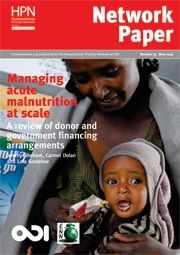
by Jeremy Shoham, Carmel Dolan and Lola Gostelow
This Network Paper is concerned with the financing arrangements for programmes that address acute malnutrition at scale through the community-based management of acute malnutrition (CMAM). The CMAM approach is geared towards the early detection, treatment and counselling of moderately and severely acutely malnourished children, in the community, by community agents.
Until the late 1990s, treatment of severe acute malnutrition (SAM) was through therapeutic feeding centres in hospitals and healthcare centres. Performance was poor, coverage was extremely limited, mortality was often in excess of 30% and recovery rates were low. The CMAM approach, was first piloted in Ethiopia in 1999 as an alternative to the centre-based model, offered the prospect of dramatically increased access to successful treatment and coverage.
CMAM has been adopted in over 65 countries yet by 2011, total reported admissions represented just 10-15% of the estimated 20m global SAM cases annually. Many countries with very high caseloads of acutely malnourished children, such as India, Nigeria and Indonesia, have extremely low CMAM coverage.
This review is a follow-up to an international conference on CMAM co-hosted by the government of Ethiopia and the Emergency Nutrition Network (ENN) in Addis Ababa in 2011, where 24 government representatives from Africa and Asia shared their experiences of scaling up CMAM, and in particular the challenges posed by unpredictable and unsustainable financing arrangements. The review looks at the management, organisation and funding channels for CMAM, both globally and at the national level. It covers humanitarian financing, as well as financing through transitional and development channels, focusing on programmes that identify, treat and prevent acute malnutrition and related mortality at scale.
Please note that a limited quantity of this Network Paper has been printed.
If you would like to receive a copy please email hpn@odi.org.uk


























